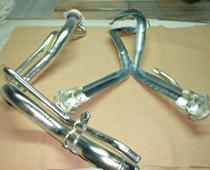Zinc prevents corrosion of iron, cast iron, and other iron-based materials sacrificially (electrochemically). Anticorrosive (antirust) performance is indicated by the time of rust formation (H) in salt spray testing (SST). Conventionally, chromate treatment using hexavalent chromium was performed to prevent white rust of zinc, but because hexavalent chromium has become unusable according to an RoHS Directive, trivalent chromium chemical conversion treatment is now mainstream.
| Type of plating | Features | SST white rust | SST red rust |
|---|---|---|---|
| Zn plating (plating thickness 8μm) |
Hexavalent unichrome | 48 H | 240 H |
| Hexavalent colored chromate | 96 H | 480 H | |
| Hexavalent black chromate | 96 H | 480 H | |
| Hexavalent green chromate | 240 H | 720 H | |
Trivalent unichrome |
96 H | 120 H | |
Trivalent colored chromate |
120 H | 240 H | |
Trivalent black chromate |
120 H | 240 H |

Zinc plating; trivalent chromate
Types of plating
Materials & uses